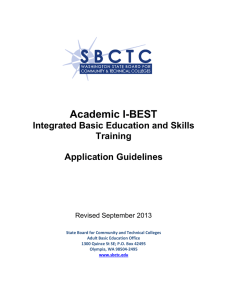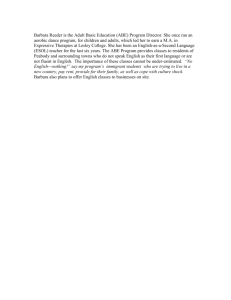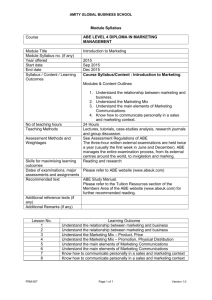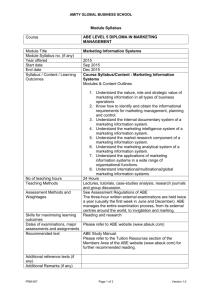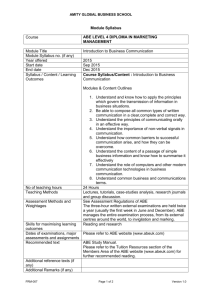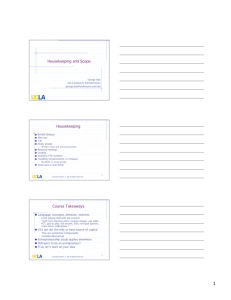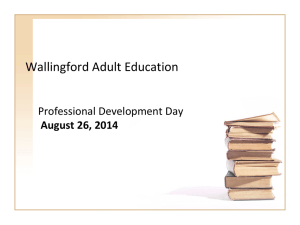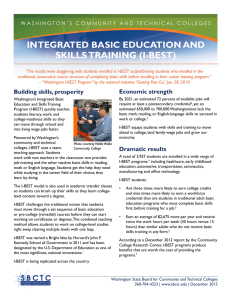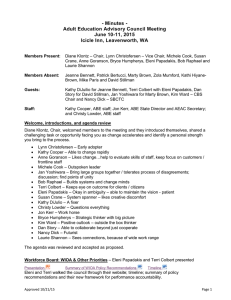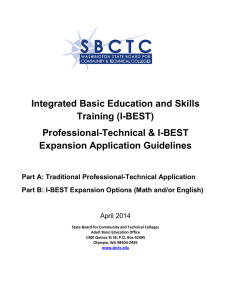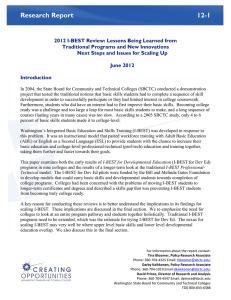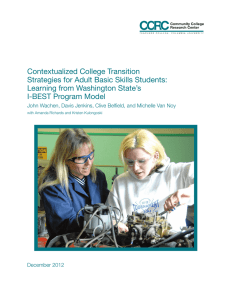From the Horses Mouth
advertisement
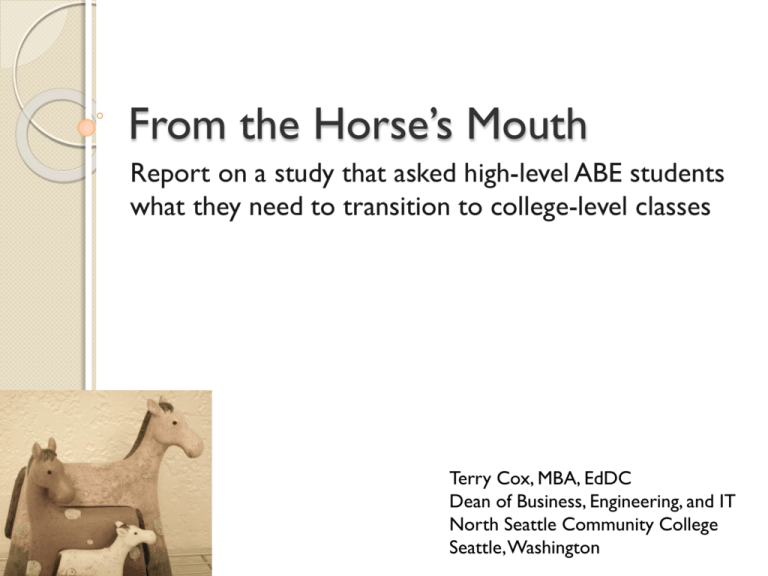
From the Horse’s Mouth Report on a study that asked high-level ABE students what they need to transition to college-level classes Terry Cox, MBA, EdDC Dean of Business, Engineering, and IT North Seattle Community College Seattle, Washington What’s going to happen… How the study idea was born Overview of Integrated Basic Education and Skills Training Methods Outcomes In their own words – basic skills students speak Results of the Focus Groups Results of the Survey DISCUSSION How the idea was born Experience as a practitioner Experience as a student Alphabet Soup ABE=Adult Basic Education ESL=English as a Second Language DevEd=Developmental Education IBEST=Integrated Basic Ed and Skills Training SBCTC = State Board for Community and Technical Colleges CASAS = Comprehensive Adult Student Assessment Systems GED = General Educational Development CCRC =Community College Research Center at Columbia University CTC = Community and Technical College OMH = Oh my heavens, what am I doing up here? Whew! First question…. HOW MANY OF YOU KNOW WHAT I-BEST IS? Rationale for IBEST: Prince (SBCTC) and Jenkins (CCRC; Columbia) 5 year study of almost 35,000 Washington adults, mostly in ABE/ESL classes Findings: ◦ Only 30% ABE and 13% ESL students get to college level coursework at all. ◦ Only 4-6% of the total ABE/ESL population get through 45 credits in the period of the study. Only 1% of ESL students who started with less than a HS education earn a GED or diploma in the 5 year period. The “Tipping Point” One year of college-level coursework, and a credential (college or industry certification) = ABE $8,500/year ESL $7,000/year GED $2,700/yr H.S. Diploma $1,700/yr IBEST Programs… In the classroom it looks like contextualized learning: Content Instructor – full time ABE/ESL Instructor- half time Support Course I-BEST as it fits with education College-level classes (numbered 100 an above) Developmental Education Some overlap & movement between – e.g. students in ABE Math level 6 often test out of Math 094, a DevEd class (content is the same) Grade 9-12 work Academic in nature; prep for college ABE 5&6 - GED Prep (practical) ABE levels 1-4 (education thru 8th grade) ESL levels 4-6 Traditionally focused on life skills English as a Second Language – literacy in the first language (ESL levels 1-3) Some overlap & movement between (students may take some developmental classes while taking collegelevel classes) North’s IBEST Pathways: NAC - 1 qtr Phlebotomy – 2 qtr Accounting – 2 qtr HVAC – 3 qtr - hybrid Most popular = NAC (every quarter) Excellent retention in all (over 80%) Closing the loop - Assessment Regression‐Adjusted Estimates of Probabilities of Outcomes for First‐Time I‐BEST, Non‐I‐BEST Workforce, and Non‐I‐BEST Non‐Workforce Students Outcome I‐BEST Non‐IB Workforce Received College Credit Received CTE College Credit College Credits Earned CTE College Credits Earned Persisted to Next Year Received Award Achieved Basic Skills Point Gain Difference in Log Wages (Post‐Prior) Difference in Adjusted Quarterly Hours Worked (Post‐Prior) 0.57 0.55 18.2 17.2 0.40 0.26 0.53 ‐0.03 ‐17.54 0.18 0.18 9.1 7.6 0.48 0.03 0.40 ‐0.02 ‐24.06 Note: From CCRC Working Paper # 20 (Zeidenbert,Cho, and Jenkins, 2010) Non‐IB Non‐Workforce 0.01 0.01 1.1 0.5 0.28 0.00 0.33 ‐0.04 ‐20.83 The best reason for I-BEST Study “Increasing Transitions to college for returning adults with low academic skills” Mixed methods Stage 1: focus groups at 3 colleges ◦ Transcribed the recordings ◦ Created themes and aggregated ◦ Built a survey from the data Stage 2: Surveys to students Proctored in upper level ABE classes At Washington State CTCs Research Questions How should community colleges design and offer programs for low-skilled adult ABE students to best mitigate the multiple barriers to college success? How many students used, or plan to use, I-BEST for transitioning into college programs? What reasons do ABE students give for not using IBEST programs? What would a perfect program be that would fit into the students’ lives? When and how would it be offered? Are there ABE students who are not interested in accessing college-level courses/programs? What reasons are given for this? How could these students be served? Focus group voices Do you want to continue into college-level courses? (Probe on why or why not) What do you know about I-BEST programs? Are you planning to use an I-BEST pathway? If not, why not? What factors do you think will help you transition into college-level classes? (Probe on life circumstances; support at the college; personal attributes) What difficulties or challenges are you facing now with staying in school? If you could design a program to fit your life better, how would that look? When, where, and how would it be offered? What supports would you need? Results 589 returned surveys from 13 institutions ◦ ◦ ◦ ◦ ◦ Demographics College Knowledge I-BEST Knowledge Expected Barriers Designing the Perfect Program Results Why don’t more students go to I-BEST programs? ◦ They just don’t know enough about them to choose them. Results, cont. Upper level ABE students don’t understand the processes for basic college entry requirements – for example, how to fill out a FAFSA or how to pick the classes they need that quarter. Students feel a fair amount of concern about this Results, cont. Former ESL students also struggle with understanding the American higher education system. The number of choices baffle them. Results, continued The systems and supports that the students identified as being most important for them in transitioning show that the most worrisome areas for Washington student are: 1. the costs of college, 2. concern about their own abilities as college students, 3. their concerns about getting good advising and planning assistance. The Perfect Program Days 4-5 days per week, a few hours per day Include advising and registration help ◦ Instructors would clearly explain what they want ◦ Instructors would care about them ◦ Tutoring would be available for them References Bloomer, T. (January 2008) Increasing Student Achievement for Basic Skills Students. SBCTC Research Report No. 08-1 Prince, D. & Jenkins, D. (November 2005) Building Pathways to Success for Low Skill Adult Students: Lessons for Community College Policy and Practice from a Longitudinal Student Tracking Study SBCTC Research Report No. 06-2 Prince, D. (April 2005) I-BEST: A Program Integrating Adult Basic Education and Workforce Training SBCTC Research Report No. 05-2 SBCTC website - Fall Reports – Selected Program Student Characteristics SBCTC website – I-BEST fact sheet http://www.sbctc.ctc.edu/college/abepds/ibest_factsheet_10.09_001.pdf Zeidenbert, M., Cho, S.W., & Jenkins, D. (2010). Washington State’s Integrated Basic Education and Skills Training Program (I-BEST): New Evidence of Effectiveness. New York: CCRC, Teacher’s College, Columbia University. Retrieved from http://ccrc.tc.columbia.edu/Publication.asp?UID=805 Thank you! questions?
